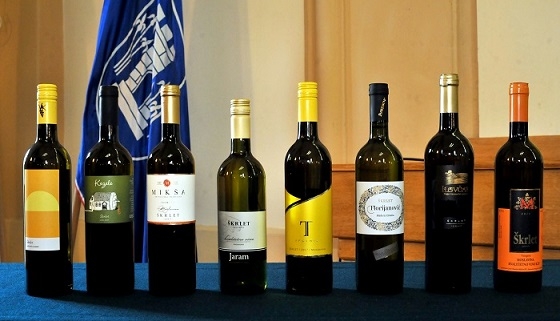18 years ago a team of experts analysed 15,000 vines of Škrlet. They singled out 80 clones, reduced the selection to 22, then to 12. And those 12 passed the strictest health tests at the Vine Institute in German Geisenheim and Australian Virology Laboratory in Adelaide, afterwards planted in the test vineyard. Two years later they chose eight of them and planted them in the test vineyard of Marko Miklaužič in Repušnica. Among those three proved as best and were registered with the Seminary Institute in Osijek, and Moslavina winemakers began using them to make wines for the market.
This is how the clone selection of Škrlet went, a multi-year project whose ending coincided with a generational change in most Moslavina wineries. Better plant material and new ways of thinking proved last year that Škrlet has a bright future. A blind tasting of nine wines proved then that there are three, maybe four visions of Škrlet. The first was traditional, with an unfermented sugar residue and unpronounced acidity. Winemakers who made such Škrlet said their consumers love it and sell it easily. This is a strong argument, but the sweet style will not guide Škrlet into the best restaurants, where it belongs.
The second style is a wine with just a few grams of sugar, but pronounced acidity. A Mosel-Riesling style. Škrlet with 6 grams of sugar and 6,2 grams of acids per liter can be very tasty, but this is a sure way to go. The third is uncompromising and we could call it Pfalz style, where they like dry Rieslings. These are Škrlets without any sugars let over where only fruitiness can provide savour, and delightful acids will ensure freshness. I am not accidentally comparing Škrlet with Riesling, this means I believe in the variety, and that third path, in my opinion, needs to become a highway which the Škrlet will travel towards the world. Or bring the world to Croatia, or Moslavina. Longer macerations of Škrlet also need attention, in stainless steel, wood and amphorae and with yeasts as those technologies will show the true potential of the variety. I write this based on previous experiences with a variety also known as Škrtec, Vinek, Osukač, Žutak and Žuti Ovnek. I regret not having a comparative tasting of new wines this year, but Škrletovo coincided with the Portugieser rating in Hungarian Pečuh.
And 19 years ago Zagreb County started the Portugizac Plešivica brand, so winemakers from Plešivica began selling traditional red young wine under a common label where only winery names differed. The story did not take off, but Plešivica still has good Portugiesers, as seen in the Portugieser de Monde rating. Among 91 Portugiesers from sevena countries, gold medals went to PZ Plešivica and wineries Kolarić and Ivančić Griffin, with the latter also receiving silver for Dark Side, a red sparkling from Portugieser, and Dark Side barrique 2016, a still Portugieser aged in wooden barrels. Silvers went also to wineries Golubić and Gregorić. Ratings took place in four categories: young wines, 2016 harvest and older, special wines (sparkling roses and sweet) and Portugieser mixes with other varieties. The PZ Plešivica Portugieser was the best among young wines and the third best rated overall, and the Griffin Rose Portugieser sparkling was best in the special category.
In previous years Croatian Portugiesers were golden, but did not win champion titles. Next year a new wine in the ripe category will compete, made by Franjo Kolarić. His 2017 harvest is still in the barrel, with plans to move it to amphorae in three months. If the young one brought him gold, maybe this new ‘miracle’ will too.
Translated from Vino.hr blog on wine, for the original click here.











